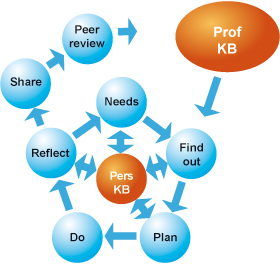Use 'Print preview' to check the number of pages and printer settings.
Print functionality varies between browsers.
Printable page generated Sunday, 23 November 2025, 6:20 AM
V26p2: E-safety KS2
Course information
This is one of the ‘project courses’ from Vital. It provides an opportunity for you to plan, carry out and evaluate a project in your classroom. It is supported by a set of resources and activities to give you ideas for possible projects. You are not expected go through every resource but to pick those which are most relevant to your interests, context and possible project.
You will need access to:
- a computer with a web browser
- headset (including microphone and speakers) for online tutorials (optional webcam)
- a class/group of students – groups could be within classes, whole classes, or groups across classes (e.g. clubs) and schools (e.g. clusters of schools or in collaborative projects).
Duration of the course: You should allow for about one to two hours per week for this on top of the time taken to do the project in your classroom or other setting.
Learning outcomes
N.B. The technology or technologies to be used are identified in the Resources section for the course.
Professional and reflective practitioner skills
At the completion of this course, you should be able to:
- identify areas within the curriculum where you can introduce e-safety learning activities
- reflect on, and discuss, the impact on e-safety of the use of technology to support learning
- select appropriate resources for the teaching of aspects of e-safety
- give advice on e-safety to pupils, fellow staff and parents
- share your learning with others in your field
- reflect on the importance of e-safety and how it fits into a whole-school approach to safeguarding.
Practical skills
At the completion of this course, you should be able to:
- use web 2.0 technologies, taking into consideration the risks to both children and adults in various online environments and applications
- teach issues of e-safety in the classroom to KS2 students
- access a range of e-safety education and awareness resources.
Knowledge and understanding
At the completion of this course, you should be able to demonstrate an understanding of:
- the range of e-safety risks which KS2 students could encounter
- the issues involved in both preventing and responding to e-safety incidents including cyberbullying
- the importance of anti-bullying, safeguarding and acceptable use policies (AUPs) and how to update these to include reference to e-safety risks and behaviour.
Cognitive skills
At the completion of this course, you should be able to:
- critically review various e-safety resources and approaches
- compare these reviews with others, constructively critiquing others’ views
- discuss different ways in which the school can develop a whole-school approach to e-safety including safeguarding and children’s use of technology at home.
Course schedule
| Week | Course activities | Type | Approximate duration |
| 1 | Activity 1 Getting to know others on the course | Online | 30 minutes |
| 1–2 | Activity 2 Exploring the resources | Online tutorial | 1 hour |
| Activity 3 Guidance on using resources and planning for project | 30 minutes | ||
| 3 | Activity 4 Drawing up course plans | Individual planning | 1 hour |
| Activity 5 Confirmation of course plans | Online tutorial | 1 hour | |
| 4–8 | Activity 6 Classroom project | Classroom | No extra time needed |
| Activity 7 Reflective journal | Individual | 30 minutes to 1 hour per week | |
| Activity 8 Keeping in touch with your cohort and facilitator | Online | 30 minutes to 1 hour per week | |
| 9 | Activity 9 Reflecting and reporting back | Online | 1 hour |
| Activity 10 Extracting our shared learning | Online | 30 minutes to 1 hour | |
| Activity 11 Course evaluation and certification | Online | 30 minutes to 1 hour | |
| Total | 9–12 hours over 9 weeks |
Introduction
The course applies a practitioner research model to look at how aspects of learning may be supported and enhanced through the use of technology. Your starting point is ‘a need’ within your practice, which you will investigate how to address. This will involve exploring how other people have already attempted to address a similar need in their practice (bringing in some practical examples of how particular technologies are used in schools), before you plan and implement their use in your school and reflect and discuss what worked and what needs further refinement.
At the heart of your learning is a project that you will carry out in your teaching and learning setting. These materials are written assuming that you have signed up for a course, although they can be followed in self-study mode. Where you have signed up for a course you will be carrying out a project with similar focus to others, both in terms of the phase of education, technology and the curriculum.
Throughout you have an opportunity to share experiences with other participants. Where you have signed up to use these materials as part of a course you will have a facilitator who will conduct tutorials and help support you in your learning and reflection.
The Practitioner Research Cycle
Vital courses are based on a Practitioner Research Cycle as shown in the diagram below.

This cycle draws on, and develops, personal and professional knowledge bases. The latter may be seen in the literature, resources, policies and other materials that are used to inform practice.
Throughout the course small icons will indicate the stage of the cycle being addressed.
NB Prof/Pers KB = Professional/Personal knowledge base
Introducing ourselves
For the purposes of clarity the activities from this point on assume that you are on a course with others. If you are in self-study mode then some activities will not be applicable.
This part of the course provides an introduction to each other, to get a feel for the contexts others are working in. This may allow for cross-fertilisation of ideas in projects and for supported reflection.
 Activity 1 Getting to know others on the course
Activity 1 Getting to know others on the course
The objective of this course activity is to get to know the other participants on this course
Task 1 Go to the course forum and the ‘Introductions’ thread. There it will explain how these introductions will be done – e.g. face-to-face, online, using a forum.
Task 2 Where a forum is used, introduce yourself, and your context, telling the other course members what you hope to get out of the course. Reply to some of these messages, identifying areas of overlap with your own context and interests.
Using the course resources in your project
These materials, are complemented by supporting resources and activities, which you can use to support your project. Your facilitator, and others on the course, will help to you to plan and refine your ideas for this project.

 Activity 2 Exploring resources
Activity 2 Exploring resources
The objective of this course activity is to develop your understanding of the resources provided to support this course.
Go to the Resources section, explore what is there and reflect on how might use them in your classroom or other setting. You are not expected to look at all of the resources, but to choose those which seem to be of most interest and relevance to you. In Activity 4, you will develop a project of your own and these resources are designed to help frame that project. As you explore you might want to make notes that you discuss with your facilitator in Activity 3.

 Activity 3 Guidance on using resources and planning for project
Activity 3 Guidance on using resources and planning for project
The objectives of this course activity are:
- to develop your understanding of the resources available
- to develop a shared understanding of suitable project resources.
Go to the course discussion forum and to the thread ‘Tutorial: Resource and project guidance’. This will contain guidance on how the tutorial will be conducted – for example, it may be online or face-to-face. The tutorial will be supported by discussion in the forum. When you attend the tutorial, online, you should be prepared to discuss initial ideas for your project.

 Activity 4 Drawing up course plans
Activity 4 Drawing up course plans
The objective of this course activity is to plan your use of the resources and associated technology in a project in your setting.
You will need to consider:
- how your plan fits with your performance management or other targets
- the classes or groups of learners to be used in the project
- the learning gains or learning intentions
- the intended purposes for using the technology and resources
- what evidence you will look for of the impact of the resources and technologies on learning and teaching
- how you will share your findings with others in your setting.
 Activity 5 Confirming course plans
Activity 5 Confirming course plans
The objectives of this course activity are to:
- develop your understanding of the resources available
- develop a shared understanding of suitable project activities.
Go to the course forum and to the thread ‘Confirming plans’. You should go to this thread and outline what you plan to do. Comment on others’ plans looking, in particular, for plans which are similar to your own so that you may share ideas and findings.
The project
Having developed your plan on how to use the supporting resources in your classroom you now need to carry out the project. This will last for about half a term. Each week, as you work through the project, you should reflect on what you have learnt and the impact it is having on learners. You should be prepared to share your thoughts and reflections with others. 
 Activity 6 Classroom project
Activity 6 Classroom project
The objective of this course activity is to carry out your plan for the use of the resources and technology in your classroom. It is not intended that, in doing so, you spend any extra time over and above your normal teaching and preparation time.

 Activity 7 Reflective journal
Activity 7 Reflective journal
The objective of this course activity is to reflect systematically on what you have learnt.
Each week you should note down what you have learnt from the project. This might take the form of reflection on your plans in Activities 3 and 4. These reflections may be kept in a blog or some other electronic journal. You will need to use these reflections to inform Activities 8 and 9.

 Activity 8 Keeping in touch with your cohort and facilitator
Activity 8 Keeping in touch with your cohort and facilitator
The objectives of this course activity are
- to share your learning as the project progresses
- to gain support from colleagues on the course
- provide support for others in the cohort.
Each week you will receive a message from your facilitator to support your progress through the course and project.
Go to the course forum and to the thread ‘Project discussions’. Share how your project is going, what you are learning and any other resources that you have found to be of use. Respond to the message sent by your facilitator.
You can also use the forum to ask for support and guidance and to support and guide others. You should check back into the forum regularly – little and often is probably the best method here (15 minutes every other day is likely to be much more useful than a one hour block once a week).
Reflect, evaluate and share with others
Having carried out a classroom project, you will share your reflections of what you learnt from it.
Use the key questions below to help evaluate your project. Use your initial planning sheet and the reflections you have captured as a source of data to help you do this.
- What did the learners do? This is a descriptive activity that explains your action with the learners.
- What did they learn and how do you know? This is an issue of assessment including observation, discussion, question and answer, testing, etc
- Was it worthwhile, i.e. did it succeed in meeting your targets? This question relates to your purposes and intended learning outcomes.
- What did I do? Practitioner research is often done by individuals in their own work. This question requires a description of your own actions.
- What did I learn? This requires analysis of your data and reflection on your answers.
- What do I intend to do next? This relates to your next steps for action. This is where you will try to do things to achieve an improvement and to make the work you do with learners more worthwhile in your terms.
Adapted from Open University Curriculum in Action materials (1981)

 Activity 9 Reflecting and reporting back
Activity 9 Reflecting and reporting back
The objectives of this course activity are
- to share your reflections on the project
- give feedback to others as they reflect on their projects.
Make a brief presentation to share your findings – maybe as a couple of slides, short video, images etc. Go to the forum, in the thread ‘Reflections’ upload your presentation, and discuss:
- the extent to which your intended learning outcomes were achieved
- the evidence you have for this
- the ways in which you shared your project with others in your setting
- key reflections emerging from the consideration of the key questions for evaluation (listed above).
The use of technology in learning and teaching will provide you with evidence that may be useful when considering the Professional Standards for Teaching. You will have collected evidence from planning through to your notes and evaluation to discussion in the forum. Such evidence may be useful to you when demonstrating ways in which you have met the standards.
Depending on the stage of your career, certain Training and Development Agency for Schools TDA standards may be more relevant than others. Click the ‘Discussion’ button to reveal a possible set of standards. If appropriate you can reflect on these in your feedback to this activity.
Discussion
 TDA standards relevant to you might include the following:
TDA standards relevant to you might include the following:
- C7 Evaluate their performance and be committed to improving their practice through appropriate professional development.
- C8 Have a creative and constructively critical approach towards innovation; being prepared to adapt their practice where benefits and improvements are identified.
- C17 Know how to use skills in literacy, numeracy and ICT to support their teaching and wider professional activities.
- C27 Design opportunities for learners to develop their literacy, numeracy, ICT and thinking and learning skills appropriate within their phase and context.
- P10 Contribute to the professional development of colleagues through coaching and mentoring, demonstrating effective practice, and providing advice and feedback.
- E2 Research and evaluate innovative curricular practices and draw on research outcomes and other sources of external evidence to inform their own practice and that of colleagues.
- E14 Contribute to the professional development of colleagues using a broad range of techniques and skills appropriate to their needs so that they demonstrate enhanced and effective practice.
Shared learning

The reflective practitioner cycle is based on developing the professional knowledge base. We have come to the end of the personal reflection phase and will now develop a common understanding of what we have learnt. We will share the key learning points as a group so that these may be collated and added to the community knowledge.
 Activity 10 Extracting our shared learning
Activity 10 Extracting our shared learning
The objectives of this course activity are to discuss and agree what we have learnt as a group.
Go to the course forum and, in the Discussion called ‘Shared Learning’, post the key learning points that have emerged for you during the course. With your facilitator, agree on the common shared learning from the group.
Evaluation
This final section allows for evaluation.
 Activity 11 Course evaluation
Activity 11 Course evaluation
The objectives of this course activity are to complete an evaluation form and rate and review the course.
Your task is to complete the evaluation questionnaire, which can be found on the course page. There are also links there to print a certificate and rate the course. The certificate will be ‘released’ by your facilitator.
Resources
You do not need to do all the activities contained in this Resources section. Select those that are most appropriate to your context, interests and possible projects.
Where possible we provide links to materials hosted by Vital. However, this is not always feasible so please bear in mind that over time material from external websites may become unavailable or obsolete.
Introduction
The role schools play in educating and equipping learners to use ICT safely and responsibly is crucial. More and more children are using mobile phones, websites and interactive applications at a younger age. It is important, therefore, that e-safety is taught throughout school.
Children’s experience of using ICT in school is generally safe and monitored. Access to the internet is usually filtered, and sites and applications that might pose a risk to children are blocked. Outside of school, however, access to the internet at home or on mobile phones is usually unfiltered. Young children will start to explore a range of sites including social networking and video hosting sites and will want to interact with a wide range of individuals and organisations, often unsupervised.
Ensuring that young children know about online dangers and are equipped to stay safe is therefore crucial. At Key Stage 2, however, it is important to cover this subject sensitively and to differentiate your lessons to take account of the various ages and stages of children and the level of their experience and confidence in using ICT. Some young learners can easily be scared and frightened when they are told of the risks of using the internet, so it is vital that the sessions are balanced and you have age appropriate resources (see below). It’s important to inform parents or carers that you are covering this topic so they are aware of the school’s commitment to safeguarding and that you are balancing the messages of safety with the positive opportunities offered by the internet.
Here are a set of resources which will give you a good introduction to the subject of e-safety and which you can use to support your project. We have included a short reflection exercise after each resource which will help you reflect on the issue specifically for Key Stage 2.
1 Why is e-safety important?
- Safeguarding children online: are you managing online risks well?
- Know It all from Childnet, http://www.childnet.com/kia/primary/teachers.aspx
- Safeguarding children online
- Welcome to Know IT All for trainees, http://www.childnet.com/kia/traineeteachers/
The publication from Becta is an excellent introduction to the importance of e-safety in schools. It will help you understand the importance of this subject within the wider safeguarding in schools framework, the importance that Ofsted places on this aspect of safety and the range of risks we should be guarding against.
Watch the Childnet introductory video clips and think about how confident you already feel in the areas for which they offer training.
Download and fill in the form on the e-safety flyer with the other members of staff in your school.
The final Childnet video provides a clear breakdown of what teachers need to do. It is written for trainee teachers but is useful for current practitioners.
Reflection
Are you and is your school e-safe?
Are there things that you would like to change?
Add your thoughts to the forum and ask how others have made changes.
Can you adopt any ideas that are already there?
2 A whole school approach
- Esafety games, http://www.rsc-northwest.ac.uk/ acl/ eMagArchive/ RSCeMag0910/ Safeguarding/ esafety_games_northwest_learning_grid.html
- Sid’s online safety guide, http://www.bizzikid.co.uk/sosguide/safetyguidestart.html
- Media Smart games, http://www.mediasmart.org.uk/kids-games.php
- Captain Kara and Winston’s SMART adventure, http://www.childnet.com/kia/primary/smartadventure/
- What should you do if?... Digital safety cards
E-safety is relevant to many areas of the curriculum and there are lots of games that have been developed for use in the Key Stage 2 classroom. Try some of these games out so that you know which aspect of e-safety is being addressed in each game.
I have printed and laminated several sets of the scenario cards and introduced one or two to the class at a time to discuss. Look through the scenarios and decide what your answer would be, are you ready to justify your answers to the children?
Reflection
There are four sets of games listed above, which ones do you feel would be best for your class?
If you were considering allocating various games to the different year groups so that there would be fresh material for each year group which set of games would you allocate to which year group?
Could any of these games be built into maths or PHSE?
Could you use the discussion cards to develop speaking and listening in literacy?
3 Cyberbullying
- Newsround special: caught in the web (only the first two minutes), http://news.bbc.co.uk/cbbcnews/hi/newsid_8490000/newsid_8495700/8495786.stm
- STOP cyberbullying, http://www.stopcyberbullying.org/kids/index.html
- Enjoy the internet safely: Click Clever Click Safe, http://www.direct.gov.uk/en/YoungPeople/HealthAndRelationships/Bullying/DG_184893
- Daydreaming – a cyberbullying resource for primary schools http://www.yhgfl.net/eSafeguarding/eSafety/Cyberbullying/Daydreaming
- Talent Show – cyberbullying prevention commercial, http://www.youtube.com/ watch?v=bdQBurXQOeQ&feature=related
Cyberbullying may start to be a problem among older pupils in primary school as pupils are given access to mobile phones and children need teaching about it so that they understand the hurt and effects that it can have on pupils.
Ideas for activities for children
Write a cyberbullying story to make a stop–motion presentation, a video presentation or any other sort of presentation about it.
Use Toondoo http://www.toondoo.com/ , Dvolver http://www.dvolver.com/ live/ home.html or a similar free online comic strip creator to make a cyberbullying exchange.
Reflection
How does cyberbullying differ from playground bullying? Add your thoughts to the wiki.
Look at the resources. Are there things that you could introduce to your class?
Are teachers affected by Cyberbullying?
Have you ever been cyberbullied?
What did you do about it? Add your thoughts to the wiki.
What would useful sanctions be for cyberbullies?
Are the same sanctions as are used for playground bullies viable or does it need something different?
4 Strangers online
- Be careful when meeting up, http://www.childnet.com/kia/primary/smartadventure/chapter5.aspx
- Faux Paw the techno cat, http://www.youtube.com/ watch?v=D0pue0KoCPk
- Internet safety, http://www.youtube.com/ watch?v=xZHq4CQekTY
- Clare thought she knew…http://www.youtube.com/ watch?v=Z5WEnqnq1Hk&feature=channel
Who is a stranger? A key question for children is who is a friend and who is a stranger. Choose one or more of these resources and describe in the forum how you would use them to improve children’s understanding of who is a stranger.
Ideas for activities with children
Before a ‘stranger’ activity, plan and distribute a survey form asking children for personal information and see how they respond. (This could include user names, passwords, age, date of birth, address, and the school they go to.) Keep these very safe until they have finished the unit of work and give the same survey form out. Return old and new copies to the children and compare – they know the ‘no personal information’ rule; did they adhere to it? Did understanding improve between the two surveys? Remember to shred all of the forms after the lesson.
Children could create an avatar to use in social networking situations rather than a photo of themselves:
- http://www.moeruavatar.com/ index_en.shtml, no sign-up needed.
- http://marvel.com/ create_your_own_superhero, allows users to sign up but it is not compulsory. Pupils can make their avatar and download it without having to give any information
- http://www.doppelme.com/, they will need to log in with an e-mail address so this may not be ideal in some classroom situations unless pupils have an address from a school e-mail system.
Present a school friendly (enhanced CRB checked) stranger to the children in a forum situation; if it is an older woman or man ask them to answer all of the pupils’ questions but to act the opposite gender and the same age as the children. After a few exchanges during which the children try to find out as much as they can about their surprise visitor ask the children to write a description of that person including hobbies, likes, dislikes, what they look like, etc. Invite that person to come into school to meet the children.
Ask the children to make posters to show how they can tell that someone online is a friend.
Reflection
Would you use these films with your children?
How could you incorporate them into your curriculum?
How do you decide that people you meet online are friends?
Have you ever been wrong?
Add your thoughts to the wiki.
5 Reliability of information
- Pacific Northwest tree octopus, http://zapatopi.net/treeoctopus/
- All about explorers, http://www.allaboutexplorers.com/
- The dog island, http://www.thedogisland.com/
- Stick insects, http://www.brookview.karoo.net/Stick_Insects/
- Is the Moon made of cheese? http://uncyclopedia.wikia.com/wiki/Is_the_moon_made_of_cheese%3F
- Detecting lies and staying true (upper KS2 only),http://www.youtube.com/ watch?v=fXFbQKz3anw&feature=player_embedded#
It is very easy for young children to assume that information found and presented as fact must be true. They need to be taught how to verify information and one of the best ways to do that may be to use spoof or hoax sites.
Look through all of the following websites and choose one to examine closely studying the quality of the information given there. Feed back in the wiki about your chosen website, is the information good? Accurate? Would you use it with children?
Ideas for activities with children
Each child or group of children could contribute a page to a wiki or an e-book about anything that they are really interested in http://myebook.com/. Once the research is finished allow each child to hide a false ‘fact’ in their work and make the wiki or book. Ask pupils to try to find the false facts from each page. Tell them to keep their findings a secret until the end when they can be shared, investigated to see whether or not the chosen facts are true or false and the outcomes discussed.
Reflection
How do you verify information found on the internet?
Can you do something in your lessons to help children start to check the quality or veracity of information found on the internet?
6 Social networking
- Safe: The National Primary school Certificate in Safe Social Networking, http://www.digitalme.co.uk/safe/
- Social networking, http://www.thinkuknow.co.uk/8_10/control/social/
- Instant messaging, http://www.thinkuknow.co.uk/8_10/control/im/
- Chatrooms, http://www.thinkuknow.co.uk/8_10/control/chatrooms/
- Game playing, http://www.thinkuknow.co.uk/8_10/control/gaming/
- Habbo hotel, http://www.habbo.com/
- Club penguin, http://www.clubpenguin.com/
- Super social safety: Habbo… good or bad? http://supersocialsafety.blogspot.com/2009/12/habbo-good-or-bad.html
- Super social safety: Club Penguin http://supersocialsafety.blogspot.com/2009/11/club-penguin-is-kids-social-site.html
- Jigsaw: assembly for 8–10-year-olds, http://www.youtube.com/ watch?v=_o8auwnJtqE
Safe is a new programme of practical activities to develop primary children's skills, self confidence and safety awareness when using social networking sites. By completing the free programme pupils gain a Safe certificate as evidence of their learning. Start the Safe certificate now or join in the discussion by clicking on the URL above.
Sign up to join Thinkuknow http://www.thinkuknow.co.uk and look at the resources to familiarize yourself with them. Watch the film called Jigsaw and think about how you could introduce it into your class. There are a range of resources available from this site but thee is a bigger range, including lesson plans, if you have done CEOP training as a teacher. Investigate whether anyone at your local authority is able to provide this training for all staff in your school.
Social networking may play a big part in pupils’ lives. They often learn the skills from older siblings or maybe their parents. They may not have been taught how to protect themselves whilst working on sites such as Habbo Hotel, Club Penguin or even Facebook. Are children’s popular social networking places safe, fun places to visit? The last two sites offer a teen’s thoughts on these sites as part of the Digiteen project.
Ideas for activities with children
Ask a child each week to demonstrate their favourite social networking site for as long as there are new sites being offered. As long as they are willing, allow them to log-in on the interactive whiteboard in front of the class and to discuss what is on the site and how it works. Ask pupils to spot any danger areas and how to deal with them. Create a class wiki with screen shots and information bites from the sessions.
Reflection
Think about how to incorporate some of the appropriate resources into your PHSE lessons and add your ideas to the wiki.
All of the children’s social networking sites give the pupils avatars. Does using an avatar protect them or make them more vulnerable? Does the clothes worn by the avatar make them more vulnerable?
Does the name they give their avatar make them vulnerable?
Are Sexy Sue 16, Purple Kitty 15 or Diablo Dave 14 suitable names for pupil avatars?
Write your thoughts about names on the wiki. Could you influence pupils’ choices?
7 Other issues
- Adults
- Spams & scams, http://www.breakthechain.org/ss.html
- Phishing scams in plain English, http://www.commoncraft.com/phishing
- Pupils
- Dangers of downloading files, http://www.bbc.co.uk/ cbeebies/ grownups/ help/ social-media
Viruses, scams, phishing, memory sticks, external hard drives, accidental access to undesirable sites, introducing malware that may bombard pupils with gambling games are all part of the whole bigger picture of keeping safe on the internet. Pupils may download copyright music or images that may cause big problems for the school or individuals at home. These are things that teachers will need to be aware of so that they can talk about issues as they arise, but also consider their own practice to be sure they are keeping their classroom and pupils as safe as possible.
What resources do you have in schools to stop anyone introducing viruses into the system? What about adware or malware? Do you have suitable software to stop them at home? Where does adware or malware come from? Do you have very tightly controlled web filtering so that you cannot access many of the sites that would give you the opportunity to download music, for instance? Is your computer use monitored? If you visit a shopping site and buy shoes whilst you are in school would anyone know?
Reflection
Filtering means various sites are blocked – this may be on the basis of words, domains, image colouring and more. Monitoring, however, is just that. Sites are monitored and hopefully any troublesome behaviour would be spotted and visits to those sites stopped before it became a problem.
Which would you prefer?
Which would be best for your children? Why?
Write your thoughts in the forum and see how others feel. Respond to other teachers’ thoughts.
Are any of the things that you try to download illegal such as music or images?
What dangers do illegal music or video downloads pose?
Do you understand the copyright rules?
Investigate creative commons licensing http://creativecommons.org/ licenses/ by-nc-sa/ 2.0/ deed.en and sites that offer CC licensed images, videos, sounds and music for schools such as http://www.nen.gov.uk/ and teach pupils to use internet resources that are available without being in breach of copyright laws.
Are memory sticks, external hard drives and similar allowed in school?
Investigate Dropbox as an alternative. Dropbox is a free (up to 2 GB usage) resource that allows users to have a folder where they can save their own files on a server accessible from anywhere at any time. A person who uses it can open their folder on any computer to access their files, http://www.dropbox.com. Users can also share those files by giving access to a web link.
8 Policies and protecting yourself
- How to report, http://www.thinkuknow.co.uk/8_10/report/, lists ways of reporting and has an example of a report button. Look out for the Report buttons in other places.
- CEOP centre corporate film, http://www.youtube.com/ watch?v=lOeQnGUSjMs
- The Bill: child abuse online – you're not alone, http://www.youtube.com/ watch?v=_ygHMTg6BSA
- The Bill: report child abuse and online grooming, http://www.youtube.com/ watch?v=HC7LQ8Bs5kA
- Where’s Klaus? http://www.youtube.com/ watch?v=-IOOn2wR8bU
Has your school got an AUP? Did you sign it? Can you remember what it says? Have you reminded the pupils about it frequently? Is it based on rules? Or rights?
Study this website, http://www.fluidoldham.co.uk/ esafety/ charter.php, it shows an e-safety charter, developed by pupils, of their rights when using the internet. How does that compare with your school’s AUP?
This website shows another charter but adds to the rights by outlining the responsibilities that go alongside, http://www.blackburn.gov.uk/ server.php?show=ConWebDoc.51178
Watch the following videos. Please be aware that you may find some of the language in the first clip offensive:
http://www.cyberbullying.info/ movies/ movie6.php
http://www.youtube.com/ watch?v=ddZWkhItPuI&feature=related
Reflection
Is your online life professional?
Can your pupils, parents, employers find out about your lifestyle, immediate family, holidays or hobbies from your web persona?
Do you abide by the rights and responsibilities?
Would it be feasible for your class, school or partnership to create your own charter?
Can you teach children about its existence and explain to them how to use it so that they are able to get help if required?
Is there anything else you could do to help the children who get messages that they do not want?
Further reading
General
The Byron Review, http://tna.europarchive.org/ 20081202015242/ dcsf.gov.uk/ byronreview/
Every Child Matters, http://webarchive.nationalarchives.gov.uk/ 20100113205514/ dcsf.gov.uk/ everychildmatters/
The Children Act 2004, http://www.opsi.gov.uk/ acts/ acts2004/ ukpga_20040031_en_1 , pages 13–16 in particular
What is social networking?, http://www.whatissocialnetworking.com/
CEOP – for teachers, http://www.thinkuknow.co.uk/ teachers/
Safeguard learners online: How are you safeguarding next generation learners?
Safeguarding in a digital world: Guidance for learning providers
How e-safety fits the PHSE and citizenship curriculum, http://www.childnet.com/ kia/ primary/ Curriculum.aspx
An overview of the kinds of technology currently being used by children, http://www.childnet.com/ kia/ primary/ Technology.aspx
The pupil view
2,800 Kids worldwide speak out on cyber safety: not all fun and games online, http://www.symantec.com/ about/ news/ release/ article.jsp?prid=20100614_01
Next generation learning – safeguarding, http://www.nextgenerationlearning.org.uk/ safeguarding or http://webarchive.nationalarchives.gov.uk/ 20110113101521/ http:/ nextgenerationlearning.org.uk/ At-Home/ Internet-safety/
Viruses
Computer viruses, http://www.kidsturncentral.com/ topics/ computers/ virus.htm
Virus, malware, adware, spyware, is there a difference? http://www.kotoritechnologies.com/ component/ content/ ?task=tag&tname=malware&type=blog
Computer viruses, http://www.newton.dep.anl.gov/ teachers/ compvir.htm
How do computer viruses work? http://www.albion.edu/ it/ software/ 51-how-do-computer-viruses-work
Cyberbullying
Cyber bullying of teachers – a growing problem for schools? http://www.teachingtimes.com/ articles/ cyber-bullying-teachers.htm
Social networking
Social networking in schools: incentives for participation http://thejournal.com/ Articles/ 2009/ 09/ 16/ Social-Networking-in-Schools-Incentives-for-Participation.aspx?Page=1
Copyright
Intellectual property rights for creative businesses, http://own-it.org
References
Acknowledgements
Author: Carol Rainbow
Reviewers: Terry Freedman, Stephen Carrick-Davies, Pete Bradshaw
Editor: Matthew Driver